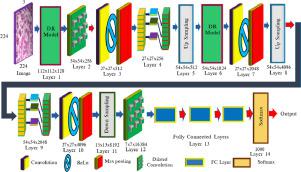Pattern Recognition Letters ( IF 5.1 ) Pub Date : 2022-05-10 , DOI: 10.1016/j.patrec.2022.04.037 Ramgopal Kashyap 1

|
Breast cancer is the most significant cause of mortality among women. When detected and treated early, it saves lives. Breast cancer detection is becoming more accessible and accurate thanks to machine learning and deep learning models. This research aims to enhance medical science and technology by employing a deep learning model to detect small cancer cells with pinpoint accuracy. The proposed model uses datasets from the Breast Cancer Histopathological Image Classification (BreakHis) and Breast Cancer Histopathological Annotation and Diagnosis (BreCaHAD). Next, the image processing procedure employs strain normalization to rectify color divergence caused by using different slide scanners, staining processes, and biopsy materials. The data augmentation with nineteen parameters such as scaling, rotation, flip, resize, and gamma value tackles the overfitting problems. The augmented images are then processed using the dilated residual (DR) model; the DR model combines the proposed dilated spatial convolution unit, fully connected dilation unit, and dilated channel convolution. The first unit is the dilated spatial convolution, which handles all channels equally and amplifies the valuable aspects. The second unit is a fully connected dilation unit; it displays low-level properties such as edges, contours, and color. The third unit is dilated channel convolution, which detects tiny objects and thin boundaries without adding complexity. The proposed dilated residual grooming kernel (DRGK) model is a 14-layer deep learning model that stretches the receptive field while retaining feature information, using the proposed DR unit and ghost model, as well as convolution, pooling, downsampling, and dilated convolution. Dilated convolutions are extensively used in the proposed model to extract features. Accuracy, the area under the curve, average precision score, precision, sensitivity, and f1 score all improve with a learning rate of 0.001. With 96.33% and 93.35% marks, the proposed approach surpasses several state-of-the-art methods.
中文翻译:

用于乳腺癌检测的扩张残余修饰核模型
乳腺癌是女性死亡的最重要原因。如果及早发现和治疗,它可以挽救生命。由于机器学习和深度学习模型,乳腺癌检测变得更加容易和准确。这项研究旨在通过采用深度学习模型以精确的精度检测小癌细胞,从而增强医学科学和技术。所提出的模型使用来自乳腺癌组织病理学图像分类 (BreakHis) 和乳腺癌组织病理学注释和诊断 (BreCaHAD) 的数据集。接下来,图像处理过程采用应变归一化来纠正由使用不同的幻灯片扫描仪、染色过程和活检材料引起的颜色差异。具有 19 个参数的数据增强,例如缩放、旋转、翻转、调整大小、伽玛值解决了过拟合问题。然后使用扩张残差(DR)模型处理增强图像;DR模型结合了所提出的扩张空间卷积单元、全连接扩张单元和扩张通道卷积。第一个单元是扩张的空间卷积,它平等地处理所有通道并放大有价值的方面。第二个单元是全连接膨胀单元;它显示低级属性,例如边缘、轮廓和颜色。第三个单元是扩张通道卷积,它在不增加复杂性的情况下检测微小物体和细边界。提出的扩张残差修饰核(DRGK)模型是一个 14 层的深度学习模型,它使用提出的 DR 单元和幽灵模型以及卷积,在保留特征信息的同时拉伸感受野,池化、下采样和空洞卷积。在所提出的模型中广泛使用空洞卷积来提取特征。准确率、曲线下面积、平均精度分数、精度、灵敏度和 f1 分数都以 0.001 的学习率提高。所提出的方法以 96.33% 和 93.35% 的分数超过了几种最先进的方法。


























 京公网安备 11010802027423号
京公网安备 11010802027423号